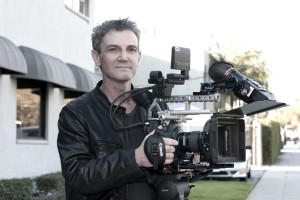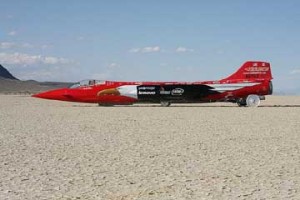
“When I am looking through a camera and capturing a definitive moment, it doesn’t really matter if it’s a still or a moving image when I press that shutter,” said Rees. “In terms of lighting, composition and visual impact, the process is very similar. Throughout my still-photography career, I have used complex lighting set-ups, jibs, dollies and other film-oriented equipment. Sound, however, was an element I never needed to consider. While the transition into motion pictures is a natural progression for the still photographer, the need to keep sound in mind was a learning experience.”
 The subject of Rees’ documentary is the brainchild of veteran engineer Ed Shadle, who has spent the past 13 years building the North American Eagle – essentially a wingless 1950s’ Lockheed F-104A Starfighter jet plane on wheels. Shadle, who is also the car’s driver, is trying break the world land speed record, which has been held by a British team since 1997.
The subject of Rees’ documentary is the brainchild of veteran engineer Ed Shadle, who has spent the past 13 years building the North American Eagle – essentially a wingless 1950s’ Lockheed F-104A Starfighter jet plane on wheels. Shadle, who is also the car’s driver, is trying break the world land speed record, which has been held by a British team since 1997.
“It is such an intriguing subject, in terms of perseverance and human endeavor – Ed Shadle’s endless pursuit of the seemingly impossible dream,” Rees enthused. “I saw this as a great story that I just had to get involved with.”
Rees’ first challenge was to find a digital cinema camera that was ergonomically similar to the Canon EOS 5D Mark II digital SLR camera he prefers for still photography, and that would also perform well in the harsh environment of the Alvord Desert. “One of the other cameras I tried was heavy and encumbered with bolt-on attachments,” explained Rees. “The Canon EOS C300, however, felt great in my hands. It has a similar feel to the classic Mamiya 645 or, more recently, the Hasselblad H3D, and the EOS C300 camera weighs just over three pounds, so they are all similar in weight. Plus, I am familiar with Canon EF lenses from my EOS 5D Mark II camera. We used Canon EF 24-70mm standard zoom lenses and 70-200mm telephoto zoom lenses on the three Canon EOS C300 EF-mount cameras we had. I also used a Canon 100mm f/2.8 macro lens to shoot cutaways of a small lizard.”
Heat posed a major challenge for shooting in the desert. Temperatures ranged from more than 100-degrees during one of Rees’ shooting days, to 28 degrees with a chilly wind six weeks later. “This desert is coated with alkali dust and a couple of the other cinema cameras I used took in dust through their air intakes and overheated,” Rees said. Canon’s proprietary cooling design features a sealed duct system that is isolated from other internal parts of the camera. This prevents incoming air from spreading dust or foreign matter through the interior of the camera body. The design also includes a super-quiet fan to avoid problems during in-camera audio recording.
“The fact that the EOS C300 camera behaved well in temperatures of over 100-degrees gave me the confidence to take one up in a helicopter,” Rees continued. “We captured gyro-mounted shots from about 100 feet above the North American Eagle, as it sped along with a majestic dust trail behind it. We also used the EOS C300 camera on a gyro-mount on a pursuit vehicle driving alongside the North American Eagle car. I love the high-speed footage I can get with Canon EF lenses on the EOS C300 camera. There was no moiré, no rolling shutter, no temporal aliasing.”
Camped-out in high desert where temperatures can plummet after sundown, the crew built a bonfire one night that gave Rees the opportunity to document the camaraderie of the North American Eagle Project’s team members. Rees credits the low-light imaging capabilities of the C300 digital cinema camera with his success in capturing this defining scene.
“We shot the crew sitting around a bonfire in the dark, lit only with the ambient firelight at 6400 ISO, and the footage is virtually grain/noise-free,” Rees explained. “We used no supplemental lighting because we didn’t want it to look artificial. Their faces were illuminated with the patterns of constantly dancing flames. It looks real because it is real. We started shooting at 3200 ISO and went to 6400 as dusk turned to dark.”
“Another thing that’s great about the EOS C300 camera is how you can alter its aperture very quickly and dial-in six extra stops of Neutral Density (ND),” Rees added. “With some cameras you have to physically insert ND filters into the separately attached matte box. The EOS C300 camera has built-in ND – up to six stops – an absolute lifesaver. I had a shot where it was below zero and snowing in the desert but still with plenty of sunshine. I was able to quickly dial-in four stops of ND with cold hands. With all the will in the world my cold hands would not have allowed me to insert 4×5 ND’s in the matte box. The shot just would not have happened.”





